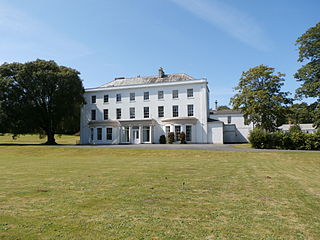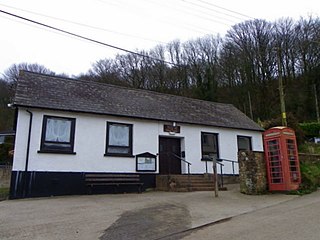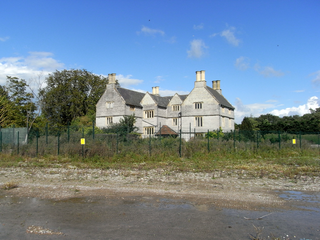
Baron Poltimore, of Poltimore in the County of Devon, is a title in the Peerage of the United Kingdom. It was created in 1831 for Sir George Bampfylde, 6th Baronet. His son, the second Baron, held office as Treasurer of the Household from 1872 to 1874 in the first Liberal administration of William Ewart Gladstone.

John Bampfylde of Hestercombe in Somerset, was an English landowner and politician who sat in the House of Commons between 1715 and 1741.

Tamerton Foliot is a village and former civil parish situated in the north of Plymouth, in the Plymouth district, in the ceremonial county of Devon, England. It also lends its name to the ecclesiastical parish of the same name.

Moreton House is a grade II listed country house and former large estate near Bideford, North Devon, England. The house is about one mile west of the old centre of Bideford town, its entrance drive leading off the south side of the road between Bideford and the village of Abbotsham. It has in recent years become increasingly surrounded by the suburbs of Bideford, and in 2014 only 5 acres of the former parkland remain attached to the house. The estate is said anciently to have been the property of the famous Grenville family, lords of the Manor of Bideford, and of Stowe, Kilkhampton in Cornwall. It was later acquired by the Buck merchant family of Bideford, which rebuilt the house in 1760 and again in 1821.

The Royal Devon and Exeter Hospital, and with a main site sometimes known as Wonford Hospital, is a large teaching hospital situated in Exeter, Devon, England, and is run by the Royal Devon University Healthcare NHS Foundation Trust.

Sir Coplestone Warwick Bampfylde, 3rd Baronet of Poltimore and North Molton, Devon, was a British landowner and High Tory politician who sat in the House of Commons from 1710 to 1727.

Sir Richard Warwick Bampfylde, 4th Baronet of Poltimore, North Molton, Warleigh, Tamerton Foliot and Copplestone in Devon and of Hardington in Somerset, England, was Member of Parliament for Exeter (1743–47) and for Devonshire (1747–76).

Sir Coplestone Bampfylde, 2nd Bt., DL, JP of Poltimore and North Molton and Warleigh, Tamerton Foliot, in Devon, was an English politician who sat in the House of Commons at various times between 1659 and 1689.

Sir John Bampfylde, 1st Baronet of Poltimore and North Molton and Tamerton Foliot, all in Devon, was an English lawyer and politician. He was one of Devonshire's Parliamentarian leaders during the Civil War.

Blackborough is a hamlet and former manor in the parish of Kentisbeare, Devon, England. It is situated within the Mid Devon district. The nearest substantial town is Cullompton, approximately 4.7 miles (7.6 km) to the south-west. Within Blackborough are situated the large mansion of Blackborough House also notable are Hayne Farm and the Old Smithy. The former neo-Gothic Early English style parish church of All Saints, built in 1838 by George Wyndham, 4th Earl of Egremont, lord of the manor, who also built Blackborough House was demolished in 1994, having become structurally unsafe. The churchyard however is still maintained and the ecclesiastical parish and parochial church council still exist.

Sir Amyas Bampfylde of Poltimore and North Molton in Devon, England, was a Member of Parliament for Devon in 1597.
George Wentworth Warwick Bampfylde, 4th Baron Poltimore (1882–1965) of Poltimore and North Molton, Devon, was a peer and major landowner in Devonshire, whose family had been seated at Poltimore from about 1300. He was a Justice of the Peace for Devon and occupied the honorary position of High Steward of South Molton, Devon.

The Manor of Poltimore is a former manor in Devon, England. The manor house known as Poltimore House survives in its 18th-century remodelled form, but has been dilapidated for several decades. A charity named the "Poltimore House Trust" has been established for the purpose of its restoration. The manor was situated within the historic Wonford Hundred and was largely coterminous with the parish of Poltimore and contained the village of Poltimore, 4 miles (6.4 km) north-east of the historic centre of the City of Exeter. It should not be confused with the eponymous Devon estate of Poltimore in the parish of Farway, 16 miles (26 km) east of Exeter. Poltimore was the principal seat of the Bampfylde family from c. 1300 to 1920.

Poltimore is a village, civil parish and former manor in the East Devon district, in the county of Devon, England. It lies approximately 5 miles (8.0 km) northeast of Exeter. The parish consisted of 122 households and a population of 297 people during the 2011 census. The parish also includes the hamlet of Ratsloe.

Warleigh is an historic estate within the parish of Bickleigh in Devon, about 6 miles from Plymouth. Warleigh House, the manor house of the manor of Tamerton Foliot is situated one mile west of that village on the south-east bank of the River Tavy where it joins the River Tamar. It was remodelled in about 1830 in the Gothic style by John Foulston and has been listed Grade II* on the National Heritage List for England since 1960.

Richard Bampfield (1526–1594) of Poltimore and Bampfylde House in Exeter, both in Devon, was Sheriff of Devon in 1576. He began construction of the Tudor era Poltimore House in 1550, and completed the building of Bampfylde House, Exeter, along with The Great House, Bristol one of the finest Elizabethan townhouses in the West Country, in 1590. He is the ancestor of the Bampfylde Baronets and Barons Poltimore.

Sydenham House, the manor house of the ancient manor of Sydenham in the parish of Wembdon, Somerset, England, is a grade II listed building, constructed in the early 16th century and refronted and rebuilt after 1613. In 1937, British Cellophane Ltd set up production and built extensive factories on 59 acres (24 ha) of land adjacent to the manor house. Production ceased in 2005 and between 2010 and 2015 the industrial site was razed to the ground. In 2015 the razed site is owned by EDF Energy, which in 2012 purchased the manor house with the former factory site, intended for construction of temporary accommodation for 1,000 workers.

Huxham is a hamlet and civil parish in the county of Devon, England and the district of East Devon and lies about 3 miles from Exeter. The parish has an area of about 800 acres and is surrounded, clockwise from the north, by Rewe, Poltimore, Exeter and Stoke Canon. It is too small to have a parish council and instead has a parish meeting. It was formerly part of the Wonford Hundred and gave its name to a family who possessed the manor from the reign of Henry II to that of Edward III. The manor was then held by the Bampfylde family of Poltimore.
Whipton Barton was an estate farm to the East of Exeter. The 'Barton' suffix is the traditional Devon wording for the manor house, and indicates a demesne in the feudal system.

Exeter Arena, formerly known as the Exhibition Fields, is an outdoor sports complex at Whipton Barton in Exeter, Devon.


















